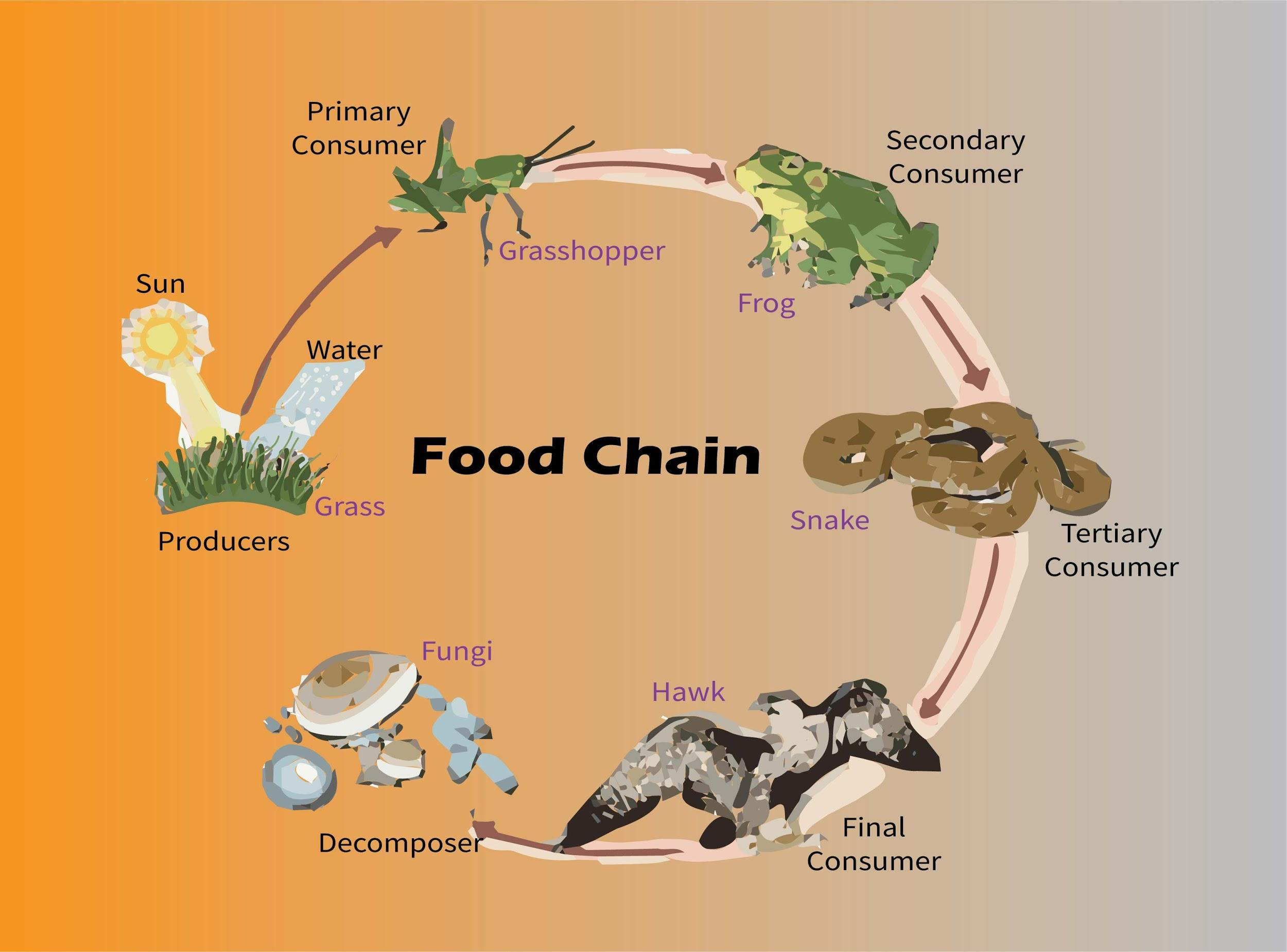
What is the correct food chain in grassland?
(a) Grass > Snake > Insect > Deer
(b) Grass > Wolf > Deer > Buffalo
(c) Bacteria > Grass > Rabbit > Wolf
(d) Grass > Insect > Frog > Snake
Answer
574.2k+ views
Hint: In an ecosystem, a series of organisms each organism dependent on the feeding of the next as a source of food is known as a food chain. It shows how the organisms are related to each other and each level of a food chain signifies a divergent trophic level.
Complete answer:
One of the ways for an ecosystem to work at its fullest is that there has to be a flow of energy. The energy is achieved in the form of food in the ecosystem. The topmost source of this energy is the sun and producers like green plants trap solar energy to convert it into the chemical energy for getting their food. A part of this energy is passed on to producers now. The primary producer is then eaten by the primary consumer; this is again eaten by a secondary consumer. This secondary consumer may be eaten by a tertiary consumer, and so on. The energy gets carried from one consumer to the next higher level of consumer. The food chain is made up of this link from producers and ending at apex predator species or decomposer species. A food chain in a grassland ecosystem starts with grass being the primary producer by trapping energy from sunlight. Insects like grasshoppers are primary consumers because they directly depend on the green plant for their food. The frog is the secondary consumer because it eats insects. The snake is a tertiary consumer and feeds on frogs for its food.

So, the correct answer is 'Grass > Insect > Frog > Snake.'
Note:
- An ecological pyramid is a graphical representation to show the relationship between different organisms in an ecosystem and each of the bars that make up the pyramid represents a different trophic level.
- Ecological pyramids are generally of three types: the pyramid of the number, pyramid of biomass, and pyramid of energy (showing the rate of energy flow).
- The pyramid of numbers shows the number of individual organisms at different trophic levels of the ecosystem. The pyramid of biomass shows the total dry weight and other suitable measures of the total amount of living matter at each level. Grassland ecosystem: The pyramid of biomass is upright, the pyramid of biomass shows a gradual reduction in biomass at each trophic level. The pyramid of numbers is also upright.
Complete answer:
One of the ways for an ecosystem to work at its fullest is that there has to be a flow of energy. The energy is achieved in the form of food in the ecosystem. The topmost source of this energy is the sun and producers like green plants trap solar energy to convert it into the chemical energy for getting their food. A part of this energy is passed on to producers now. The primary producer is then eaten by the primary consumer; this is again eaten by a secondary consumer. This secondary consumer may be eaten by a tertiary consumer, and so on. The energy gets carried from one consumer to the next higher level of consumer. The food chain is made up of this link from producers and ending at apex predator species or decomposer species. A food chain in a grassland ecosystem starts with grass being the primary producer by trapping energy from sunlight. Insects like grasshoppers are primary consumers because they directly depend on the green plant for their food. The frog is the secondary consumer because it eats insects. The snake is a tertiary consumer and feeds on frogs for its food.

So, the correct answer is 'Grass > Insect > Frog > Snake.'
Note:
- An ecological pyramid is a graphical representation to show the relationship between different organisms in an ecosystem and each of the bars that make up the pyramid represents a different trophic level.
- Ecological pyramids are generally of three types: the pyramid of the number, pyramid of biomass, and pyramid of energy (showing the rate of energy flow).
- The pyramid of numbers shows the number of individual organisms at different trophic levels of the ecosystem. The pyramid of biomass shows the total dry weight and other suitable measures of the total amount of living matter at each level. Grassland ecosystem: The pyramid of biomass is upright, the pyramid of biomass shows a gradual reduction in biomass at each trophic level. The pyramid of numbers is also upright.
Recently Updated Pages
Master Class 12 Business Studies: Engaging Questions & Answers for Success

Master Class 12 Economics: Engaging Questions & Answers for Success

Master Class 12 English: Engaging Questions & Answers for Success

Master Class 12 Maths: Engaging Questions & Answers for Success

Master Class 12 Social Science: Engaging Questions & Answers for Success

Master Class 12 Chemistry: Engaging Questions & Answers for Success

Trending doubts
Which animal has three hearts class 11 biology CBSE

1 Quintal is equal to a 110 kg b 10 kg c 100kg d 1000 class 11 physics CBSE

Explain zero factorial class 11 maths CBSE

The camels hump is made of which tissues a Skeletal class 11 biology CBSE

How do I convert ms to kmh Give an example class 11 physics CBSE

The percentage of free SO3 in oleum sample which is class 11 chemistry CBSE




